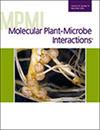Gokulan C G, Sohini Deb, Namami Gaur, Apoorva Masade, Niranjan Gattu, Rennya P R, Nisha Sao, Donald James, Ramesh V Sonti, Hitendra K Patel
求助PDF
{"title":"米黄单胞菌。oryzae iii型效应物Tal9b靶向广泛保守的疾病易感位点促进水稻发病","authors":"Gokulan C G, Sohini Deb, Namami Gaur, Apoorva Masade, Niranjan Gattu, Rennya P R, Nisha Sao, Donald James, Ramesh V Sonti, Hitendra K Patel","doi":"10.1094/MPMI-10-24-0139-R","DOIUrl":null,"url":null,"abstract":"<p><p><i>Xanthomonas oryzae</i> pv. <i>oryzae</i> (<i>Xoo</i>), the causal agent of bacterial blight of rice, translocates multiple transcription activator-like effectors (TALEs) into rice cells. The TALEs localize to the host cell nucleus, where they bind to the DNA in a sequence-specific manner and enhance gene expression to promote disease susceptibility. <i>Xoo</i> strain PXO99<sup>A</sup> encodes 19 TALEs, but the host targets of all these TALEs have not been defined. A meta-analysis of rice transcriptome profiles revealed a gene annotated as flavonol synthase/flavanone-3 hydroxylase (henceforth <i>OsS5H/FNS-03g</i>) to be highly induced upon <i>Xoo</i> infection. Further analyses revealed that this gene is induced by PXO99<sup>A</sup> using Tal9b, a broadly conserved TALE of <i>Xoo</i>. Disruption of <i>tal9b</i> rendered PXO99<sup>A</sup> less virulent. OsS5H/FNS-03g functionally complemented its <i>Arabidopsis</i> homologue AtDMR6, a well-studied disease susceptibility locus. Biochemical analyses suggested that OsS5H/FNS-03g is a bifunctional protein with salicylic acid 5' hydroxylase (S5H) and flavone synthase-I (FNS-I) activities. Further, an exogenous application of apigenin, the flavone that is enzymatically produced by OsS5H/FNS-03g, on rice leaves promoted virulence of PXO99<sup>A</sup> <i>tal9b<sup>-</sup></i>. Overall, our study suggests that OsS5H/FNS-03g is a bifunctional enzyme, and its product, apigenin, is potentially involved in promoting <i>Xoo</i> virulence. [Formula: see text] Copyright © 2025 The Author(s). This is an open access article distributed under the CC BY-NC-ND 4.0 International license.</p>","PeriodicalId":19009,"journal":{"name":"Molecular Plant-microbe Interactions","volume":" ","pages":"579-588"},"PeriodicalIF":3.4000,"publicationDate":"2025-07-01","publicationTypes":"Journal Article","fieldsOfStudy":null,"isOpenAccess":false,"openAccessPdf":"","citationCount":"0","resultStr":"{\"title\":\"<i>Xanthomonas oryzae</i> pv. <i>oryzae</i> Type III Effector Tal9b Targets a Broadly Conserved Disease Susceptibility Locus to Promote Pathogenesis in Rice.\",\"authors\":\"Gokulan C G, Sohini Deb, Namami Gaur, Apoorva Masade, Niranjan Gattu, Rennya P R, Nisha Sao, Donald James, Ramesh V Sonti, Hitendra K Patel\",\"doi\":\"10.1094/MPMI-10-24-0139-R\",\"DOIUrl\":null,\"url\":null,\"abstract\":\"<p><p><i>Xanthomonas oryzae</i> pv. <i>oryzae</i> (<i>Xoo</i>), the causal agent of bacterial blight of rice, translocates multiple transcription activator-like effectors (TALEs) into rice cells. The TALEs localize to the host cell nucleus, where they bind to the DNA in a sequence-specific manner and enhance gene expression to promote disease susceptibility. <i>Xoo</i> strain PXO99<sup>A</sup> encodes 19 TALEs, but the host targets of all these TALEs have not been defined. A meta-analysis of rice transcriptome profiles revealed a gene annotated as flavonol synthase/flavanone-3 hydroxylase (henceforth <i>OsS5H/FNS-03g</i>) to be highly induced upon <i>Xoo</i> infection. Further analyses revealed that this gene is induced by PXO99<sup>A</sup> using Tal9b, a broadly conserved TALE of <i>Xoo</i>. Disruption of <i>tal9b</i> rendered PXO99<sup>A</sup> less virulent. OsS5H/FNS-03g functionally complemented its <i>Arabidopsis</i> homologue AtDMR6, a well-studied disease susceptibility locus. Biochemical analyses suggested that OsS5H/FNS-03g is a bifunctional protein with salicylic acid 5' hydroxylase (S5H) and flavone synthase-I (FNS-I) activities. Further, an exogenous application of apigenin, the flavone that is enzymatically produced by OsS5H/FNS-03g, on rice leaves promoted virulence of PXO99<sup>A</sup> <i>tal9b<sup>-</sup></i>. Overall, our study suggests that OsS5H/FNS-03g is a bifunctional enzyme, and its product, apigenin, is potentially involved in promoting <i>Xoo</i> virulence. [Formula: see text] Copyright © 2025 The Author(s). This is an open access article distributed under the CC BY-NC-ND 4.0 International license.</p>\",\"PeriodicalId\":19009,\"journal\":{\"name\":\"Molecular Plant-microbe Interactions\",\"volume\":\" \",\"pages\":\"579-588\"},\"PeriodicalIF\":3.4000,\"publicationDate\":\"2025-07-01\",\"publicationTypes\":\"Journal Article\",\"fieldsOfStudy\":null,\"isOpenAccess\":false,\"openAccessPdf\":\"\",\"citationCount\":\"0\",\"resultStr\":null,\"platform\":\"Semanticscholar\",\"paperid\":null,\"PeriodicalName\":\"Molecular Plant-microbe Interactions\",\"FirstCategoryId\":\"99\",\"ListUrlMain\":\"https://doi.org/10.1094/MPMI-10-24-0139-R\",\"RegionNum\":3,\"RegionCategory\":\"生物学\",\"ArticlePicture\":[],\"TitleCN\":null,\"AbstractTextCN\":null,\"PMCID\":null,\"EPubDate\":\"2025/8/12 0:00:00\",\"PubModel\":\"Epub\",\"JCR\":\"Q2\",\"JCRName\":\"BIOCHEMISTRY & MOLECULAR BIOLOGY\",\"Score\":null,\"Total\":0}","platform":"Semanticscholar","paperid":null,"PeriodicalName":"Molecular Plant-microbe Interactions","FirstCategoryId":"99","ListUrlMain":"https://doi.org/10.1094/MPMI-10-24-0139-R","RegionNum":3,"RegionCategory":"生物学","ArticlePicture":[],"TitleCN":null,"AbstractTextCN":null,"PMCID":null,"EPubDate":"2025/8/12 0:00:00","PubModel":"Epub","JCR":"Q2","JCRName":"BIOCHEMISTRY & MOLECULAR BIOLOGY","Score":null,"Total":0}
引用次数: 0
引用
批量引用

 求助内容:
求助内容: 应助结果提醒方式:
应助结果提醒方式:


